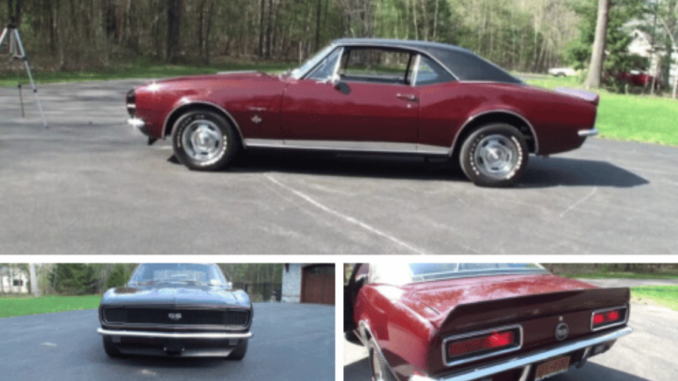
How many 1967 SS/RS Camaros were built? This question is reserved for the most proper gearheads, VIP members of the most fervent muscle car fan organizations, and ultra-fundamentalists of Detroit’s automotive world. I’ll be the first to acknowledge that I have no idea, but maybe someone else can shed some light on this troubling situation. Where did I get the concept from? based on a single genuine, unaltered, numbers-matching sample.
It is incomprehensible to us simple mortals why it matters so much to the inhabitants of Planet Piston whether a vehicle has factory-installed options, panels, components, trims, and powertrain or not. But in the razor-sharp eyes of enthusiasts, this is what makes or breaks a vintage car. The big reward comes when one such survivor continues to drive and operate as it did on day one.

Finally, the first-generation, first-year Camaro that featured in this episode of Lou Costabile’s YouTube video is revealed. The crank gods sent the people of 2023 the Madeira Maroon sport coupe with the black vinyl top. Although the livery’s owner calls it “burgundy, the trim tag clearly shows what color it really is.
Please also notice that the SS package giveaway sign inaccurately refers to the hood decorations as “ice cube trays.” The 1968 model’s name was given to it due to the louver’s design, which had four openings that resembled cubes. Despite a few tiny semantic problems, the RS option on this prehistoric Camaro makes it seem good.
The Rally Sport (the R and S) was an advance in terms of appearance, and it had a noticeable visual influence. At least, it seemed like there were no headlights on the RS-equipped vehicles up close. Or, for the untrained eye, up close. The lights would emerge from behind the hidden doors with only one button press while also turning on.

It’s interesting to note that the early RS vehicles featured electric motors for the light flaps, which caused General Motors a lot of trouble. Actuators weren’t very dependable, and warranty problems flooded dealerships. Eventually, a recall effort changed the cool function for all problematic RSs to vacuum operation.
The precise number is presumably hidden away in the Chevrolet archives, along with the illustration showing the SS/RS package. Although none had anything to do with racing and weren’t sporty, 64,842 Camaros left production lines festooned with Rally Sport extras.

Another distinguishing feature of the RS was the back-up lights beneath the rear bumper, and the vehicle would have boasted of its rebellious, no-bowtie, black grille that displayed the distinctive badging. Although our hero had a distinct symbol, the letters were placed vertically.
The 1967 Camaro was the real deal—the speed and thrill vehicle that would, in GM’s vision, “eat the Mustangs”—hence the double S for Super Sport. The SS package option was installed in 33,273 automobiles, and it did more than simply change the clothing.

The 350 CID (5.7 liters) small-block or the high-performance 396 CID (6.4 liters) big-block were the only available engines for the SS during the initial model year, compared to the eight available for the normal Camaro. With 29,270 units depending on its 295 hp gross power output and 380 lb-ft of torque (299 PS or 515 Nm), the standard 350 was by far the most popular engine in 1967.
This vehicle from our narrative is one of the vehicles that popularized the 350 V8 in the L48-code build sheet engine choice. Its original configuration had a hydraulic cam, a quadrajet carburetor with four barrels, and a 10.25:1 compression ratio. The engine, gearbox, and rear end are all factory-installed components, according to the owner.
The engine was a 327-cubic-inch (5.3-liter) engine that had been given a second life, and it carried over the short journal crankshaft. Additionally, the Turbo-Fire badges on the front fenders have nothing to do with forced induction—the V8 is naturally aspirated—thanks to the era’s marketing mania.
The SS gearboxes came in four-speed close-ratio Muncie manual or two-speed Powerglide automatic varieties, depending on the size of the engine. Midway through the year, the three-speed Turbo-Hydramatic was added.
The video shows that the current owner isn’t hesitant to drive the automobile the way it was intended to be driven. The Camaro was a nice matching-numbers surprise, much to his delight, even though the previous seller had not mentioned this when he sold it to the back-buying dealer. But since the Chevy man is an auto expert, he had a Camaro specialist check it first. Almost two decades later, here we are.
With the Camaro, Chevrolet sought to kill two birds with one stone by outperforming the Corvair and entering the feeding frenzy that followed Ford’s Mustang’s commercial success. Even though the Camaro had almost instant success on the racetracks and replaced the rear-engined Corvair as the leader in the internal Chevy hierarchy for the small-body market, it failed to outsell the Blue Oval wonder in sales.
Additionally, this car differs somewhat from the standard ’67 RS/SS models in one particular way, and it has nothing to do with the aftermarket radio—the original is still in the vehicle. It just resides in the trunk. Even the owner doesn’t understand the little switch to the left of the steering wheel. Some viewers make the assumption that it may be the switch for the fog lights, while others make the anti-theft starting solenoid control switch assumption. This final solution, meanwhile, seems a little unrealistic since a safety system that is installed in plain view and is easy to reach doesn’t really deter auto thieves.
Để lại một phản hồi